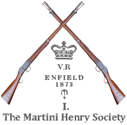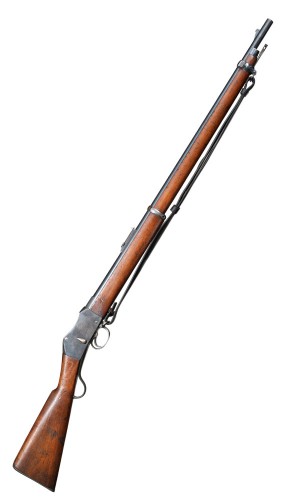Martini Henry Rifle MkVI (Martini Metford MkII)
| Calibre | .303” Metford |
| Date of Approval | Pattern sealed 12th March 1890 |
| Length | 49.5” |
| Weight | 9lb 11oz |
The MkV1 rifle was the last of the official Martini Henry arms to be given the M-H title. However, the official pattern drawing re-names the arm the Martini Metford MkII. The origins of the rifle can be traced to a contract balance for 38,000 M-H mark II’s for the Indian government cancelled in 1889, it was decided to bore 9,600 rifles to .303” Metford rifling, but retain the heavy profile barrel. The weight of the arm was a hefty 9lb 13oz average, due entirely to the barrel thickness, but otherwise it had all the appearance of a conventional Martini Henry arm. The Contract for these rifles was to the BSA & MCo, therefore a new specification was issued on the 7th January 1890 for the arm and the new pattern was sealed on 12th March 1890.
The initial design had the Lewes Pattern notched foresight, however, this sighting arrangement proved unfit for service, and was subsequently abolished. The MkVI was held from issue until the sighting issues could be rectified, it was not until March 1893, when over 4900 rifles were in store at Weedon, the MkV1 had the Lewes sight converted with a barleycorn tip being added, fastened with a small cross pin. The MkVI breech block was a new design, based upon the original Martini Henry MkIV pattern 74 block, but with a narrow feed slot to centralize the loading, and like the MH MkV, a conventional MkIV extractor, but with narrower extractor claws for the .303 base.
The first issue of the MH MkV1, was made with cordite sighting, with 760 rifles being delivered to Natal, and 57 to Zululand, unusually these rifles had a wooden handguard fitted as the Lee Metford rifle. As the first issue MH MkVI rifles had been sighted for cordite, Dominion forces who had large stocks of Black powder .303 cartridge placed orders that required Black powder sighting, and Weedon carried out the sighting alteration, Canada accepted a 1000 rifles, however, immediately issues were found with the thicker chamfered base of the Mk1 & Mk2 solid .303” cartridge, the base prevented the block from being raised and it is not known if the Canadians ever put them to use. However, it was recognized as a problem and the rifles in store at Weedon had chamber alterations carried out to rectify the problem.
Standard approved bayonet for the M-M MKII was the Pattern 1887 sword bayonet.However Canada ordered 1000 (1001 were made) special conversions of the 1888 Lee medford Sword bayonet made under contract from Wilkinson in 1894. These are found RRCI and M & D marked
Distribution of the MkVI was widespread, 200 issued to Zululand on the 14th Feb 1896, 766 to Jamaica between June 1896 & July 1897 and 200 additional black powder sighted rifles being sent to West Australia on the 30th April 1897.






